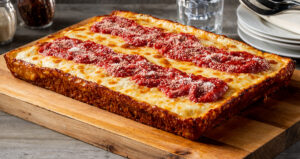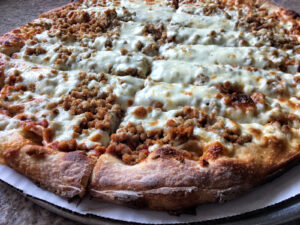 I grew up about 40 miles outside of Chicago. Like a lot of families in our area, we ate pizza often, either as a meal or a late-night snack. The two pizzerias we patronized the most were Gario’s (still in business) and Tony Weed’s (out of business). In later years, when I was old enough to drive, Ach-N-Lou’s pizza became a favorite. If we were having frozen pizza, it was almost always Tombstone.
I grew up about 40 miles outside of Chicago. Like a lot of families in our area, we ate pizza often, either as a meal or a late-night snack. The two pizzerias we patronized the most were Gario’s (still in business) and Tony Weed’s (out of business). In later years, when I was old enough to drive, Ach-N-Lou’s pizza became a favorite. If we were having frozen pizza, it was almost always Tombstone.
I loved pizza, but as a kid, I didn’t know that Chicago had the reputation for being the pizza capital of North America, a title that New York-style pizza fans might dispute. In fact, I was in my late 20s or early 30s before I ever had deep-dish pizza, that gastronomical delight that most people associate with Chicago.
In those days, I was blissfully ignorant about the pizza scene in the Chicago area. I loved our local pizzerias, but I also took them for granted. I didn’t realize that I was eating some of the best pizza in the nation. But once I was introduced to Chicago-style deep-dish, my eyes were opened to the many different varieties of pizza on offer at pizzerias around Chicago, and from coast-to-coast.
Chicago vs New York City
Let me take a quick side trip to address the Chicago vs New York City pizza debate. In a recent poll conducted by USA Today, 49% of respondents proclaimed Chicago as the pizza capital of the United States. Thirty percent voted for New York City, 12% said they’d eat pizza anywhere (that seems like a cop out to me), and 9% voted for another city or region in the United States.
Although I’m gratified to see that Chicago won the poll (I’m nothing, if not a homer), I think it misses the point. New York-style pizza can be great. My go-to place in my new home is a New York-style pizza joint. It’s fantastic. To me, the big difference between New York and Chicago, at least when it comes to pizza, is that pizzerias in New York overwhelmingly serve New York-style pizza, while pizzerias in Chicago serve a wide variety of different types of pies. It’s the variety that, to me, makes Chicago the true pizza capital of America.
The following is not a comprehensive list of pizza styles. I’m a pizza snob, but in many ways, I’m still a novice when it comes to the art of pizza making. With that caveat out of the way, here are the type of pizzas you might consider the next time you have an urge for a little bit of Italian-inspired happiness.
Oops…One final caveat: Many of the types of pizzas I’m about to discuss overlap from one style to another. For instance, there are a lot of similarities between thin, Chicago-style thin, and New York-style pizzas. And yet, they are completely different. When it comes to pizza, the details really matter.
Okay, enough caveats. On with the list:
Thin Crust Pizza
 While you could argue that “thin-crust pizza” is a generic term, there’s nothing generic about eating a thin-crust pizza. To qualify as thin-crust, one obvious criteria is that the crust must be thin (duh!). To put a finer point on it, the crust is not deep and not pan, but it’s also not as thin or crispy as a Chicago-style thin (see below). It tends to be a little thicker and chewier than a Chicago-style thin, which has a crispier bite.
While you could argue that “thin-crust pizza” is a generic term, there’s nothing generic about eating a thin-crust pizza. To qualify as thin-crust, one obvious criteria is that the crust must be thin (duh!). To put a finer point on it, the crust is not deep and not pan, but it’s also not as thin or crispy as a Chicago-style thin (see below). It tends to be a little thicker and chewier than a Chicago-style thin, which has a crispier bite.
A thin-crust pizza has a rim of crust that can be used as a “handle” when eating a slice. The crust is usually firm enough to carry the load of cheese and other ingredients, unlike a New York-style pizza that often has a flimsy crust. Thin crust pizzas can either be cut into wedges (like New York-style pizza) or into squares (known as the “party cut) like Chicago-style thin.
A good example of a thin crust pizza is served at Italian Fiesta Pizzeria, a favorite of the Obamas. The pizza at Italian Fiesta is cut into squares and has a slightly thicker crust than a Chicago-style thin. It also has the crust “handle” that further separates it from a Chicago-thin.
If you can’t make it to Chicago for thin crust pizza, pick up a Home Run Inn frozen pizza at the store. It’s not quite as good as the pizza you’d be served in one of their numerous pizzerias around Chicago and the suburbs, but it will likely be the best frozen pizza you’ve ever had.
Chicago-Thin Pizza
 Imagine you’re a Chicago bar owner in the early part of the twentieth century. You want to increase business, but you don’t have a ton of money to spend. What would you do?
Imagine you’re a Chicago bar owner in the early part of the twentieth century. You want to increase business, but you don’t have a ton of money to spend. What would you do?
What some bar owners did was make inexpensive pizzas with extremely thin (but sturdy) crust to feed to the after-work crowd. The hope was that by feeding their customers, they’d stick around a little longer rather than rushing home to dinner, and if the pizza they served was a little salty, maybe the customers would buy another beer or three.
Initially, the pizzas, which were cut into squares to make them more like a snack, were given away free. But in time, they became so popular that bar owners began charging for the pizzas. Some even transformed from bars into pizzerias.
Chicago-style thin is also known as tavern-style due to its history. Despite reports to the contrary, Chicago-style thin is the true Chicago-style pizza. Chicago-style deep dish or stuffed pizza is more for out-of-towners or special occasions. I love deep-dish, but only have it a couple of times a year. Chicago-style thin is on the menu much more often.
As the name implies, a thin crust is a hallmark of Chicago-style thin. It’s thinner than regular thin crust, yet it’s still sturdy enough to carry the load of ingredients. Unlike thin, there is no “handle” of crust along the edge. The cheese goes all the way to the edge, making it slightly more difficult to eat, but well worth the effort. Chicago-style thin is always cut into squares, partly because it doesn’t have the crust edge.
In Chicago, two of the most well-known Chicago-style thin crust pizzerias are Vito & Nick’s on South Pulaski Road, and Pat’s Pizza and Ristorante on N. Lincoln Ave. Be warned, if you visit Vito & Nick’s, bring cash. They don’t take credit cards.
New York-Style Pizza
 Until now, I have supported the notion that Chicago is a better pizza town than New York. Let me throw a little love New York’s way. One way New York City outshines Chicago when it comes to pizza is in the number of “By-the-slice” options they offer. If you have a hankering for pizza at lunchtime in Chicago, you’re most likely going to have buy a whole pizza. In NYC, there’s practically a “By-the-slice” joint on every other block.
Until now, I have supported the notion that Chicago is a better pizza town than New York. Let me throw a little love New York’s way. One way New York City outshines Chicago when it comes to pizza is in the number of “By-the-slice” options they offer. If you have a hankering for pizza at lunchtime in Chicago, you’re most likely going to have buy a whole pizza. In NYC, there’s practically a “By-the-slice” joint on every other block.
The most famous New York-style pizzeria (at lest to people who don’t live in NYC) is Sbarro’s. But don’t be fooled into thinking Sbarro’s is typical New York-style pizza. In the same way Chicago-style deep dish has an out-sized reputation in Chicago, Sbarro’s has an out-sized reputation in NYC. It’s not what locals eat.
New York-style pizza has a thin crust, but unlike either thin crust or Chicago-style thin, New York-style crust is more flimsy. Almost always cut into wedges (or slices), the lip of a slice of New York-style pizza will droop. To beef it up a bit, aficionados of New York-style will fold the slice in half lengthwise, so as to not lose any of the ingredients onto the ground, or worse yet, your lap.
It has been my experience that most New York-style joints skimp on the sauce, at least in comparison to Chicago-style pizzas. And because that crust is not as firm, the bite is often chewier than either thin or Chicago-style thin.
A good representation of New York-style “By-the-slice” pizza in Chicago is Dimo’s Pizza on North Damen Ave. or North Clark Street. Another good New York-style joint is Paula & Monica’s Pizzeria on West Chicago Ave. But be warned, New Yorkers claim that you can only get true New York-style pizza in NYC because of the NYC water that is used to make the dough. I’m not sure if that’s true, but thought you should know.
Chicago-Style Deep-Dish
 There is a story that has been around for a long time that claims that Ike Sewell created the first Chicago-style deep dish pizza in the 1940s in his Chicago restaurant, Pizzeria Uno. While it’s almost certainly true that the Chicago-style deep dish originated at Pizzeria Uno, it almost certainly wasn’t Ike Sewell who created it. It’s much more likely that his partner, and the main cook at Pizzeria Uno, Ric Riccardo, is the man we have to thank for Chicago-style deep dish.
There is a story that has been around for a long time that claims that Ike Sewell created the first Chicago-style deep dish pizza in the 1940s in his Chicago restaurant, Pizzeria Uno. While it’s almost certainly true that the Chicago-style deep dish originated at Pizzeria Uno, it almost certainly wasn’t Ike Sewell who created it. It’s much more likely that his partner, and the main cook at Pizzeria Uno, Ric Riccardo, is the man we have to thank for Chicago-style deep dish.
What started off as a lark in Ric Riccardo’s kitchen soon became a Chicago hallmark. Other restaurants began imitating the deep-dish creation, and soon, the likes of Gino’s East, Lou Malnati’s, and Connie’s began springing up around town.
Chicago-style deep-dish pizza is a cross between a pizza and a casserole. It’s made in a deep-sided, round pan. The dough is spread across the pan and is pressed so it goes up the sides. The crust itself is thin. The cheese, sauce, and other ingredients make it deep. In contrast, the crust is thick with thick crust pizza. It is a common misconception that deep dish and thick crust are the same. They are NOT! The pizzas may be roughly the same depth, but they are made very differently.
Next, the pizza is made in reverse order to a thin crust. The cheese goes on first, directly on the dough. Next comes the ingredients, such as sausage, pepperoni, or, if you’re a true Chicagoan, giardiniera (If you’re not a true Chicagoan, you may need to Google it). The sauce goes on top.
Let’s take a second to talk about the sauce. In some ways, Chicago pizza culture is split right down the middle. Generally speaking, the Southside prefers a sweeter sauce, so many Southside pizzerias add sugar to their sauce. Northside pizzerias usually forego the sugar. Of course, life is never that straight forward. Over the years, Southside pizzerias have expanded onto the Northside, and vice versa, spreading their unique sauce into new territory. Today, there still is a bit of a North-South split, but it has become much more of a mish mash of styles and sugar content.
I’m a fan of Gino’s East, Lou Malnati’s, and Connie’s, but the best Chicago-style deep-dish pizza I have ever had was at My Pi Pizza on North Damen Ave. (If you Google it, you’ll see it referred to as “My Pie, My Pi, Mi Pie, and Mi Pi, Officially, the name is My and the mathematical symbol for Pi, but that doesn’t work on the internet, so the web address is Mypiepizza.com, even though they refer to themselves as “My Pi.” Go figure.) For me, it was tastier and less filling than Chicago-Style deep dish I have had elsewhere.
Chicago-Style Stuffed Pizza
 Think of Chicago-style stuffed pizza as a variation on a theme. It’s like deep-dish, but there are differences. Just like a Chicago-style deep dish, the stuffed pizza is built in a deep-sided, round pan. The dough is spread across the bottom of the pan and up the sides. Next, the ingredients are added, then the cheese, usually shredded mozzarella. This is backwards from how deep-dish pizza is made.
Think of Chicago-style stuffed pizza as a variation on a theme. It’s like deep-dish, but there are differences. Just like a Chicago-style deep dish, the stuffed pizza is built in a deep-sided, round pan. The dough is spread across the bottom of the pan and up the sides. Next, the ingredients are added, then the cheese, usually shredded mozzarella. This is backwards from how deep-dish pizza is made.
Rather than sauce going on next, a thin layer of dough goes over the top of the cheese, separating it from the sauce, which goes on top of the second layer of dough. Parmesan cheese and oregano are often sprinkled over the top of the sauce after cooking.
I like stuffed pizza but have to admit that something is lost when the sauce, cheese, and ingredients don’t mingle while cooking. It’s not a big difference, but depending on the pizzeria, can be noticeable.
Giordano’s is the biggest name in Chicago-style stuffed pizza. After all, they created it back in the 1970’s. Nancy’s is also really good, and like Giordano’s, they have several locations around the city and suburbs. A place I hear is good, but have never tried, is Suparossa, with two locations; one on North Central Ave and one on West Lawrence Ave.
Thick Crust
 Thick Crust pizza is actually a generic name for a few different styles of pizza. For years, Pizza Hut has offered a thick crust pizza that is in reality, a variation of a Sicilian-style pizza. Technically, French bread pizza would also fit in this category. Detroit-style pizza also qualifies as thick crust pizza.
Thick Crust pizza is actually a generic name for a few different styles of pizza. For years, Pizza Hut has offered a thick crust pizza that is in reality, a variation of a Sicilian-style pizza. Technically, French bread pizza would also fit in this category. Detroit-style pizza also qualifies as thick crust pizza.
Another area that New York excels over Chicago is when it comes to Sicilian pizza. Until recently, there were very few Sicilian joints in Chicago. However, that is changing.
To qualify as Sicilian, or what New Yorkers call Grandma-style, the dough must be thick, and the pizza must be cooked in a rectangular bakery-style sheet pan. The dough itself is left to rest and ferment for anywhere from one to five days. The longer it ferments, the more moisture it absorbs, creating a spongy texture.
Like thin crust pizzas, the sauce goes on the dough, followed by the ingredients, then the cheese. For my taste, Sicilian-style pizzas often have too little sauce and not enough cheese. However, that’s a personal preference. Others might feel differently.
Properly made Sicilian crust, although thick, should be light and airy. If not, the crust will be dense and overpower the rest of the pizza. This is one reason I don’t like French bread pizza. Too much bread.
In New York, and increasingly in Chicago, Sicilian-style pizzas are made in bakeries. This usually leads to a fluffier, flakier crust that supports the pizza, but doesn’t dominate it.
Full Shilling Public House on North Clark Street (near Wrigley Field) makes an awesome Sicilian-style pizza. But be warned: although they serve food all week long, Sicilian-style pizzas, which are made by Anthony Scardino (who goes by the handle “Professor Pizza”), are only available on Fridays and Saturdays.
Similar to Sicilian-style pizza, Detroit-style pizza is made with thick crust in a rectangular pan. However, the Detroit-style pizza crust is different. Detroit-style pizza crust dough uses bread flour, which increases the gluten content and makes the dough more elastic and chewier. Properly made Detroit-style crust should be similar to focaccia bread. Like Sicilian-style crust, if not made correctly, Detroit-style crust can be dense and overpowering.
Cheese is pushed up against the side of the (normally aluminum) baking sheet, giving the pizza a browned edge where the cheese is charred. To get a good, dark charring (and for taste), Detroit-style pizzas are often made with higher-fat Wisconsin brick cheese. This charring on the edges is often the favorite part of the pizza for Detroit-style lovers.
Detroit-style sauce is acidic with a hint of sweetness. It is applied sparingly, either just before cooking or on top of the pizza right after it is taken out of the oven. Although any ingredients can be used on a Detroit-style pizza, the iconic ingredient is traditional circle pepperoni, which cups and chars, holding a tiny bit of liquified fat, which is tasty, if not healthy.
In the interest of full discloser, I have to admit that I’ve never had a Detroit-style pizza that I liked. It may have been that the crust wasn’t made properly, or it could be that I just don’t like thicker crust pizzas (I tend to think it is the latter). Even so, I have heard that Fat Chris’s Pizza and Such on West Foster Ave has excellent Detroit-style pizza.
Artisan Pizza
 What makes a pizza an artisan pizza? That can be a difficult question to answer. Often there are big differences from one artisan pizza to another. However, the common similarity between artisan pizzas is the passion for changing and improving the pizza that the chef puts into their creation.
What makes a pizza an artisan pizza? That can be a difficult question to answer. Often there are big differences from one artisan pizza to another. However, the common similarity between artisan pizzas is the passion for changing and improving the pizza that the chef puts into their creation.
Artisan pizzas are usually not mass-produced, and rarely, despite notable exceptions, are these pizzas available at more than one location. The chef usually starts their experimentation with the crust, trying different flours, temperatures, and fermentation times to develop a crust that offers a unique bite.
Next, they source the freshest ingredients and offer gourmet-type toppings normally not found in other pizzerias, such as smoked lake fish, chili, kimchi, and pickled onions. Different sauces might also be used (like creamy taleggio and scented truffle oil), as well as artisan and gourmet cheeses not usually found in pizzerias. Then, the entire concoction is often cooked in a wood- or coal-fired oven. The result is a pizza unlike anything you’ve likely ever had before.
Two well-respected artisan pizzerias in Chicago are Bungalow by Middle Brow on West Armitage Ave and Paulie Gee’s Logan Square on North Milwaukee Ave. Both come highly recommended.
California-Style Pizza
 California-style pizza is a type of artisan pizza, but gets it’s own category due to it’s popularity. Introduced at Spago, the hip Hollywood eatery owned by Wolfgang Puck, Chef Ed LaDou created California-style pizza in 1982,
California-style pizza is a type of artisan pizza, but gets it’s own category due to it’s popularity. Introduced at Spago, the hip Hollywood eatery owned by Wolfgang Puck, Chef Ed LaDou created California-style pizza in 1982,
California-style pizza crust is a thin version of a Neopolitan-style pizza, but the toppings are often unique, including thai chicken, pineapple and ham, carne asada, broccoli, kale raab, and arugula.
A couple of California attorneys saw the potential of Ladou’s creation and started California Pizza Kitchen, the largest purveyors of California-style pizza in the nation. They have 250 locations nationwide, including locations in Skokie on Old Orchard, Northbrook on Lake Cook Road, Schaumburg on East Golf Road, Deer Park on North Rand Road, and in Oakbrook on Oakbrook Center.
Roman Pizza

I have to admit, I’m not familiar with Roman-style pizza, or what is more properly called Roman al taglio (“by the cut”). For this new-to-me type of pizza, I’ll turn to my pizza mentor, Steve Dolinsky,* to explain:
“The ‘al taglio’ refers to a process involving scissors. You tell the employee behind the counter how much of the pizza you’d like—using your fingers or other pantomime—then they’ll cut it from the rectangular pan and weigh it. You pay by the pound. The slices are topped with all manner of seasonal and regional specialties. Personal favorites include a thinly shaved zucchini accented with freshly ground black pepper and bright lemon zest, but you’d be struck by how good the potato-mozzarella is, or the octopus. They (Bonci) recently started making an “Italian Beef” flavor with the namesake, thinly shaved, plus homemade giardiniera.
“The pizzas are stretched and baked in large steel rectangular pans, but after they’ve baked on the stone decks of the Castelli ovens imported from Italy and you’ve placed your order, the employee will reheat the slice in a different oven, then cut them into tiny, almost tapas-sized squares for easy eating. The focaccia-like interior is the result of three flours, a lot of water in the dough, and a thirty-six-to-seventy-two-hour fermentation. The second bake ensures a hallmark of all Roman pies: they must be crispy.”
I am struck by not only how different a Roman al taglio pizza is, but how the entire ordering and preparation process is different. It almost feels like Roman-style pizza is pizza in name only, like it’s a different class of food. Even so, I’m open to giving it a try.
If you’d like to try it, check out Bonci on North Sangamon Street. According to Steve Dolinsky, Bonci will soon be expanding to New Orleans and Miami.
Neapolitan Pizza
 Purveyors of Neapolitan-style pizza are serious about their craft. The pizza, which originated in Naples, Italy, must be made according to certain instructions which are promulgated and enforced by the Vera Pizza Napoletans (VPN).
Purveyors of Neapolitan-style pizza are serious about their craft. The pizza, which originated in Naples, Italy, must be made according to certain instructions which are promulgated and enforced by the Vera Pizza Napoletans (VPN).
Some of the instructions that must be followed include:
- Only use “00” (highly refined) flour in the dough
- Water must be at a certain pH level
- Sea salt and compressed solid yeast must be used
- San Marzano tomatoes must be used
In addition, there are rules for how many times the dough must rise and even what type of oven the pizza is cooked in.
Purveyors of Neapolitan pizza are represented by the Association of Neapolitan Pizza Makers, a trade organization that publishes an official guide. The guide explains how the pizza should look and taste once it comes out of the oven:
“The consistency of the pizza should be soft, elastic, and easy to manipulate and fold. The center should be particularly soft to the touch and the taste and appearance of the pizza must be evidenced by the red color of the tomato. For the Pizza Marinara, the green of the oregano and the white of the garlic must be homogeneously spread, while, in the case of the Pizza Margherita, the white of the mozzarella should appear in evenly spread patches, in contrast with the green of the basil leaves, slightly darkened by the cooking process. The crust should possess the flavor of well-baked bread. The slightly acidic flavor of the densely enriched tomatoes, mixed with the characteristic aroma of the oregano, garlic, or basil ensures that the pizza, as it comes out from the oven, delivers its characteristic aroma of fresh and fragrant typical Mediterranean product.”
Wow! That’s impressive. So, what is Neapolitan pizza?
The crust for a Neapolitan pizza is thin, but not as thin as you would expect from a normal thin-crust pizza. Many different types of ingredients can be used on a Neapolitan Pizza, but only one of two types of chesses is acceptable. The first is Mozzarella di Bufala Campana, which is made with the milk of water buffalos. The second option is Fior di Latta di Agerola, made with cow’s milk from the Agerola region of Italy.
A favorite in Chicago for Neapolitan pizza is Panino’s Pizzeria on North Broadway Street (they also have restaurants in Evanston and Park Ridge). Eatly on East Ohio St. is also popular with the Neapolitan crowd.
New Haven-Style Pizza
 Technically, New Haven-style pizza is a variation on a traditional Neapolitan pizza. Frank Pepe Pizzeria Napolitano in New Haven, CT (hence the name) originated the New Have-style pizza, or what locals call “apizza.”
Technically, New Haven-style pizza is a variation on a traditional Neapolitan pizza. Frank Pepe Pizzeria Napolitano in New Haven, CT (hence the name) originated the New Have-style pizza, or what locals call “apizza.”
The New Haven-style crust is thin, similar to a Neapolitan pizza, and is often oblong, as opposed to round. The pizza is normally cooked in a coal-fired oven, giving it a charred, chewy bite. The sauce and cheese are both applied sparingly, making a New Have-style pizza drier than most other pizzas.
Another thing that sets a New Haven-style pizza apart from other pizzas is the use of local seafood as an ingredient. For instance, Frank Pepe Pizzeria Napolitano’s signature pie is a white clam pizza, featuring the Neapolotan-style crust, olive oil, oregano, grated cheese, chopped garlic, and little neck clams.
Although Frank Pepe is the Godfather of New Haven-style pizzas, others have jumped in with their own offerings, including Sally’s Apizza and Modern Apizza. Although New Haven-style pizza has gained popularity in recent years, it is still primarily available in New Haven, CT.
St. Louis-Style Pizza
 If you like thin crust pizza–I mean super thin and cracker crisp–then you’ll probably like St. Louis-style pizza. The dough starts with unleavened (no yeast) flour that creates a crust similar to a Matzo cracker. The toppings are generally the same toppings you’d find at most any other style of pizzeria, but it’s the cheese that really sets it apart.
If you like thin crust pizza–I mean super thin and cracker crisp–then you’ll probably like St. Louis-style pizza. The dough starts with unleavened (no yeast) flour that creates a crust similar to a Matzo cracker. The toppings are generally the same toppings you’d find at most any other style of pizzeria, but it’s the cheese that really sets it apart.
St. Louis-style pizzerias use Provel cheese, a white processed cheese that remains gooey even when it’s cold. This is the reason St. Louis-style pizza has the reputation for being the best next-day-eat-it-cold, style of pizza.
The sauce is normally sweet, and is heavy on oregano, giving the pizza a unique flavor. Like Chicago-thin pizzas, St. Louis-style pies are normally cut into squares rather than slices, and it is common to order a salad-to-share to enjoy alongside the pizza.
To get the true St. Louis-style pizza experience, you’ll want yo visit the restaurant that started it all. Imo’s Pizza has several locations around the St. Louis area, as well as locations in Illinois and Kansas.
Quad City-Style Pizza
 In case you didn’t know, the Quad Cities are made up of Rock Island and Moline, Illinois, and Davenport and Bettendorf, Iowa. The Quad Cities area also consists of several smaller towns in northwestern Illinois and Southeastern Iowa.
In case you didn’t know, the Quad Cities are made up of Rock Island and Moline, Illinois, and Davenport and Bettendorf, Iowa. The Quad Cities area also consists of several smaller towns in northwestern Illinois and Southeastern Iowa.
There are a few things that set Quad City-style pizza from other thin crust pizzas. The first is that the hand-tossed crust is made with a spice mix that includes malt, giving the crust a toasty, nutty flavor. Like other thin crust pizzas, Quad City-style pies have a crust “handle” around its edge.
The sauce is spicier than most Chicago-style sauces, containing red pepper flakes and ground cayenne. The sauce is also thinner than most Chicago-style sauce, and is applied more sparingly, making for a slightly drier pizza.
The sausage used on some Quad City-style pizzas is also unique. It is heavy on fennel (like many Chicago-style pizzas), and is applied as an entire layer on the pie. This is similar to the way Gino’s East applies their sausage, but, because the sausage is ground twice on Quad City-style pizzas, it is less like a patty (as with Gino’s East) and more crumbled, like you would expect with ground beef taco meat.
One final unique feature of Quad City-style pizza is that it is cut into strips, rather than slices or squares. This involves making one cut down the center of the pizza, then five or six perpendicular cuts across the pie.
Two of the originators of Quad City-style pizza are Frank’s Club Napoli in Silvis, IL and Harris Pizza in Rock Island, IL (Hat tip to Don Fry for the recommendations). I’ve had Quad City-style pizza at Davis Bros. Pizza in East Peoria, IL. To be sure, the pizza is different from what I am used to, but I liked it a lot.
Pizza Pot Pie
 Some (like Steve Dolinsky) would argue that pizza pot pie isn’t really pizza, but I’ve included it because 1) I’ve had it and liked it, and 2) my friend, Faith Morley, who was like a second mother to me when I was growing up, loves it. So, let’s talk about pizza pot pie.
Some (like Steve Dolinsky) would argue that pizza pot pie isn’t really pizza, but I’ve included it because 1) I’ve had it and liked it, and 2) my friend, Faith Morley, who was like a second mother to me when I was growing up, loves it. So, let’s talk about pizza pot pie.
First, you can only get it at one place that I know of, and that’s The Chicago Pizza and Oven Grinder Company on North Clark. The restaurant is housed in an old building right across the street from where the infamous St. Valentines Day Massacre took place.
The pizza pot pie was dreamed up in 1972 by Albert Beaver, a Chicago attorney who wanted to open a restaurant. Beaver’s creation is an individual serving entrée (half-pounder or one-pounder) and consists of a bread-type crust made into a bowl, a sauce of olive oil; fresh garlic; onions; green peppers; whole plum tomatoes; sausage made from Boston butts; large, whole, fresh mushrooms; and a gob of different cheeses.
The pizza pot pie is cooked in a bowl and flipped table-side by the server. Plunging a fork into the pizza pot pie creates a delicious, oozing stream of cheese, sausage, mushrooms, and all of the other ingredients.
Pizza pot pie may not technically be pizza, but Faith likes it, and that’s good enough for me.
Pizza Puff
 In the 1970s, deep-dish pizza was all the rage in Chicago. It was new and different, and places like Gino’s East, Lou Malnati’s and Connie’s were doing big business. All of the business going to deep-dish pizza joints cut into the revenue of Chicago-style hotdog carts and restaurants around the city. They needed something new to compete with the pizzerias.
In the 1970s, deep-dish pizza was all the rage in Chicago. It was new and different, and places like Gino’s East, Lou Malnati’s and Connie’s were doing big business. All of the business going to deep-dish pizza joints cut into the revenue of Chicago-style hotdog carts and restaurants around the city. They needed something new to compete with the pizzerias.
Enter Elisha Shabaz.
Shabaz was an immigrant from Iran who came to the U.S. in 1898 as a 14-year old, and landed in Chicago a few years later. As an adult, Shabaz went into the tamale business, first hand-rolling tamales for another business, and then starting his own tamale company, Iltaco Food Company (IL-TA-CO).
In the 1960s, Elisha’s grandson, Warren Shabaz, took over Iltaco, and expanded the business. He delivered tamales to many of the hotdog carts around town, and in the 1970s when the second pizza wave hit Chicago, the hotdog carts approached the younger Shabaz to find a solution to the business they were losing to pizzerias.
Almost all of the hotdog carts already had deep fryers, so Shabaz created a phyllo dough-wrapped “puff” that was stuffed with pizza sauce, cheese, and sausage, and could be quickly cooked in a deep fryer. This new creation was a bit like a mini-calzone or panzerotti, weighing in at six ounces and filled with flavor.
The pizza puffs were a hit, and Shabaz and his sons have ridden their popularity to the point where they are now available in 42 states. To this day, the pizza puffs are still hand-rolled at Iltaco’s West Town location, and are available in several different flavors including pepperoni, four cheese, spinach and cheese, and even a breakfast pizza puff.
Like pizza pot pie, pizza puffs may not technically be pizza, but they are uniquely Chicago, and they’re delicious.
Conclusion
At one time, I thought pizza was pizza was pizza. I couldn’t have been more wrong. I now know that my favorite pizza is a Chicago thin (or tavern thin). I love deep dish pizza, and now know the difference between deep dish and stuffed, which I also love. I’ve never had a Roman pizza, have only had Neapolitan pizza once or twice (I like it), and I’m sad to report that I’ve never had a Detroit-style pie that I liked. I’m a big fan of St. Louis-style pizza, I get a little weirded out by the gourmet ingredients used on many artisan and California-style pizzas, and I have to admit that a New York-style pizza can be absolutely delicious.
What’s your favorite?
* I have learned a tremendous amount from 13-time James Beard Award winner Steve Dolinsky, the Chicago-based food critic, writer, podcaster, and TV personality, about the history and intricacies of pizza. Steve runs a fantastic Chicago pizza tour business, works for NBC in Chicago, and has written two fantastic books about pizza (particularly the Chicago pizza scene). Pizza City USA is a listing and description of the 101 best pizzerias in the Chicago area. The Ultimate Chicago Pizza Guide is a bulked up, updated version of Pizza City USA, giving more history of pizza, more history of the pizzerias covered in the book, and a more current listing of Chicago’s best pizzerias.
NOTE: Recommendations for pizzerias in this essay are my own, or were made by Steve Dolinsky in one of his great books.
Addendum: The aforementioned Steve Dolinsky has created a show about pizza in Chicago that he is currently pitching to cable channels and streaming services. Here’s the pilot he created to generate interest:
